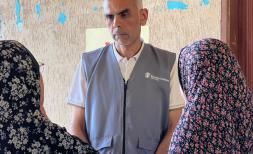Aid is keeping Afghan children alive, but it can’t fix an economy in crisis

Samar*, 11, weave carpets to help support their family in Afghanistan.
Samar* doesn’t go to school as much anymore. Instead, the 11-year-old spends half his day sewing rugs with his 15-year-old brother Zalmay*.
The economic crisis in Afghanistan means his family, who had a good life before the Taliban regained power, now struggle to survive. Sending Samar to work was an agonising decision for his parents.
He said: “I was going to school before August 2021 and now I am not going to school [as often]. I don’t like making rugs — it makes me so sad.”
It’s a year since the Western military presence in Afghanistan ended. A year since panic-stricken people flocked to Kabul airport, trying to flee the country, and girls and women waited fearfully for the disintegration of their hard-won rights.
Now, more than half the population of Afghanistan needs urgent assistance. The economy is collapsing — the result of years of conflict, natural disasters, poor governance and now international sanctions. On top of that, the country is feeling the effects of the COVID-19 pandemic, drought and looming famine, and a devastating earthquake in June.
A Save the Children survey found four-in-five children had gone to bed hungry in the past 30 days, many of them too weak to play and study. With food prices rising, desperate parents are taking their children out of school and sending them to work to help provide for the family. This will only add to the 10 million already at risk of dropping out of school, including girls who are banned from attending secondary school in most regions.
Many boys and girls we spoke to in focus groups also said they could not get medical help for financial reasons, even if a clinic was nearby. Thirteen-year-old Reza* told us his baby niece died because his family couldn’t afford the treatment needed to save her life. “We lost her due to a lack of money,” he said.
The people of Afghanistan need our support more than ever. Humanitarian organisations like Save the Children are doing everything we can to keep children alive. But humanitarian aid was never meant to be a long-term fix. This is an economic crisis, and it needs an economic solution.
When the Taliban took power in August 2021, governments around the world reacted by withdrawing billions of dollars in international aid and freezing Afghanistan’s foreign currency reserves. A year on, they still haven’t found a way to get that money back into the country.
Without long-term funding for things like education and healthcare, there is no future for children in Afghanistan. They will continue to die from hunger, malnutrition and disease. Without the chance to go to school, they will never grow up to be the teachers, doctors and economists the country needs to get back on its feet.
It would be a moral failure to let another year pass without resolving this crucial issue.
The international community needs to act now – to find a way to restore development aid to Afghanistan and solve the cash-flow problem.
Until they do, they are complicit in the loss of every Afghan child who dies from hunger and disease.
*Names changed to protect identities.
How can I help children in Afghanistan?
Send a message of hope to girls in Afghanistan.
Donate to children in crisis and help children in countries like Afghanistan.







